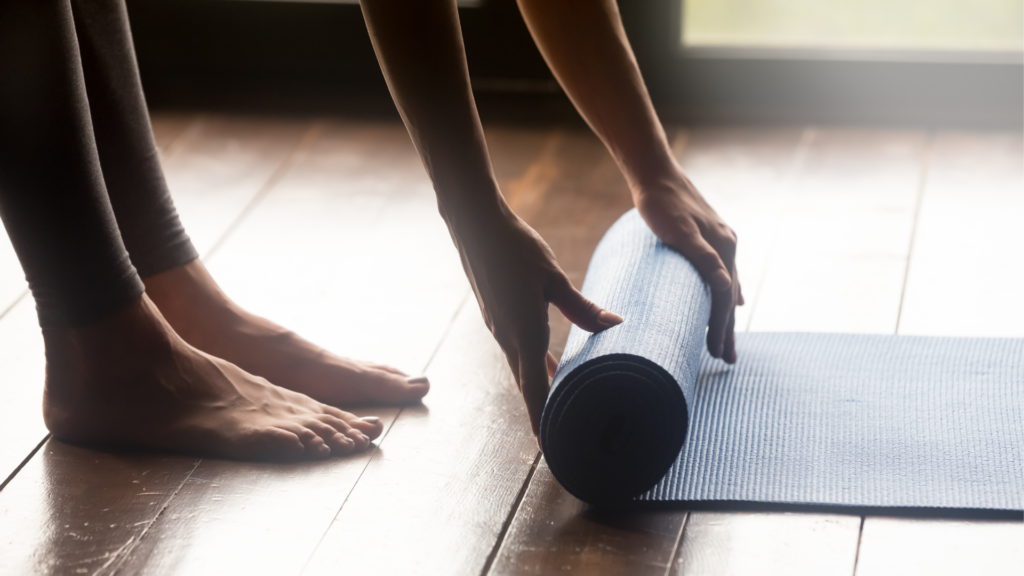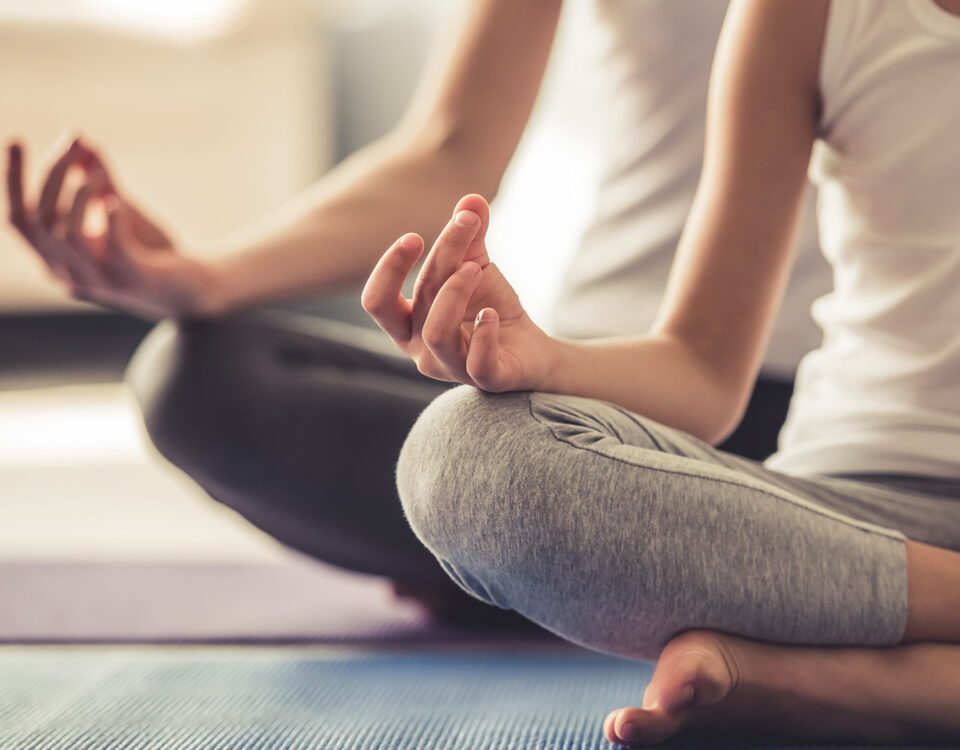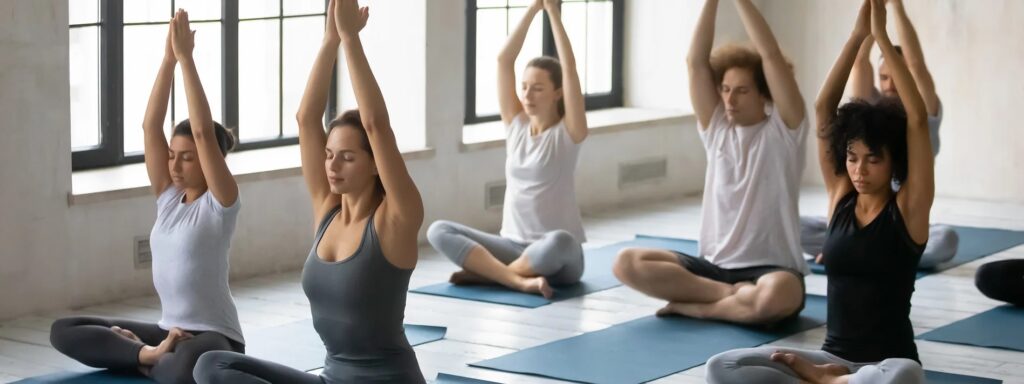Yoga For Beginners: Tips and Lingo

Being new to yoga and starting a practice can be intimidating for a lot of new yogis. You can search the internet and find an overwhelming amount of information related to poses, must-have tools or accessories, and the latest fashion and trends. These articles tell you how easy it is to become an enlightened yogi on the path to finding your balance and inner peace.
I don’t know about you, but my introduction to yoga wasn’t quite that simple. It was easy for me to get lost in a class, end up on the wrong side, and I literally had no idea what Savasana was or what I was supposed to be doing in that final rest at the end of class. And while I can’t promise you’ll find your inner peace, I can give you some basic tips to help you get started with a rewarding yoga practice.
In this post I’ll show you all the basics a beginner needs to know so you can show up at your first class ready to go!
What Is Yoga?
Yoga is an ancient practice that dates back over 5,000 years. The poses were originally designed for use with meditation. (Apparently all those ancient yogis got bored meditating in Sukhasana or “easy seat” all day.) The practice evolved over time into the many forms of yoga we know today with focus placed mainly on the mind-body connection, breathing, and increasing flexibility and well-being.
Benefits of Yoga
There are so many benefits of yoga that I won’t list them all here, but here are a few you might find interesting:
- Relieves stress
- Creates a sense of peace of calmness
- Relaxes the mind
- Improves mental clarity
- Increases flexibility
- Increases muscle strength
- Helps improve posture
- Increases bone strength
- Lengthens muscles
- Decreases toxins
- Increases mobility of the joints
- Calms the nervous system
…And so many more. Yoga is proven to have amazing benefits to your health and well-being. It can be a great exercise for everybody, no matter your level of fitness. There are variations on almost every pose and the more difficult poses can always be modified if needed.
One of the biggest stumbling blocks for new yogis is falling into the comparison trap. When you’re in a yoga class, you do not need to look like everyone else in the class, and you certainly do not need to look exactly like the teacher. Their role is to model the ideal version of the pose for educational purposes, and a good teacher will teach progressively and offer variations for more difficult poses. The most important thing to remember is to make your practice your own. We are all unique, and our bodies all come with certain challenges and limitations. You know what is best for you and your body, and I promise that Sheila one mat over is not watching you or judging you for how you move through your poses. (And if she is, she’s missing the point of yoga entirely.)
You will encounter students with a wide range of abilities, and instead of letting it make you feel self-conscious or insecure, know that they are more likely to be judging their own practice than that of others. Our bodies change from day to day, and so does our practice. Instead of placing judgment on your practice, put your focus on being present and noticing what is happening for you in the moment.
So, now that you know what yoga is and what the benefits are, let’s move on to learning some of the common lingo you’ll be likely to hear in your first class.
5 Elements of a Yoga Class For Newbies

If you are going to a yoga class for the first time, you’re most likely going to hear some words that might be new, and some of them will be Sanskrit words because that is the language of yoga. I’m here to share the most common yoga lingo and what the words mean so you can start your first class or practice with confidence!
Pranayama
When broken down, Prana means “breath”, and Yama means “control”, so the practice of pranayama you might find yourself doing at the beginning of class is simply teaching you different methods of controlling the breath. Some common breathwork might be box breathing (taking each inhale and exhale for a count of 4 or 6 to even out the breath), simple breath awareness by focusing on the sensations of the inhales and exhales, or more advanced breathwork like Ujjayi, or Ocean Breath (breathing while constricting the back of the throat) or Kapalabhati breath, also know as Breath of Fire (taking one slow inhale and several short, forceful exhalations). These breathing exercises are meant to help release tension, get centered, and bring you into a state of mindfulness.
Sun Salutation
There are two versions of Surya namaskar, or Sun Salutations, which are a series of postures done as a warm-up before moving into more advanced sequences and poses. These beginning poses take you through a series of stretches, forward folds, and backbends that are designed to build heat and they follow a rhythmic cadence that aligns with your breath.
Vinyasa
A sequence of poses where you coordinate movement with your breath. (Starting to see a pattern here?) Most common versions of vinyasa are a flow that moves from high plank pose, and either lowering to the belly or hovering over the mat in Chaturanga (Four-limbed staff pose), then coming into Cobra or Upward facing Dog, and then into Downward Dog. This is where you will see students veering off into the many different variations because the more you flow through Vinyasas, the more you will learn which version you like the most.
Asana
This word simply means “seat” and refers to the physical poses and postures practiced during yoga. There are 84 traditional yoga asana.
Savasana
Also known as “corpse pose”, Savasana is the final resting pose at the end of practice. Typically taken lying down with the legs extended and the arms along the sides, palms facing up, this pose allows you to absorb and integrate all the benefits of your practice in a peaceful, relaxed way. The teacher may turn down the lights and play soothing music. Sometimes you rest in this pose in silence, and other times the teacher may lead a guided meditation for total relaxation. While lying down can seem like a simple thing, this can be the most challenging part of a practice for some people.
What To Know For Your First Class
Here are some more tips on how to prepare for your first class:

Wear Comfortable Clothes
Wear clothing that is comfortable, but not too loose. You will be exploring poses that have you bending over, stretching, and moving in all different kinds of ways. You don’t have to buy any special clothes to do yoga, but you should wear something that has a tighter fit while still allowing you to move comfortably. A loose t-shirt should be avoided as it will have a tendency to slip up or fall over your head in poses like Downward Facing Dog.
Go Barefoot
We practice yoga barefoot for a few reasons. Yoga mats are designed for bare feet and hands, so wearing socks could cause you to slip during practice, and the last thing you want is a pulled muscle. Also, when your feet are in contact with the ground, you’ll be able to feel how you are standing on your feet and find more stability in your poses.
Practice On An Empty Stomach
When the stomach is full, some movements, such as forward folds, twists, and inversions will not be vey comfortable. If you do want to eat before class, eat a snack or a light meal one to two hours before class. This will ensure you are more comfortable during your practice. When it comes to water, it’s a good practice to drink fluids before class to keep yourself hydrated.
Turn Off All Devices
Leaving cell phones and smart devices in the car or in your cubby are the best practice, but with our busy, modern lives, you will see many people bringing them to class. Please be respectful of your fellow yogis and turn off or silence your cell phone or smart watch. Use your practice to focus on yourself and as an opportunity to leave the stresses, responsibilities, and demands of life at the door.
Equipment
There is very little you actually need in order to start your yoga practice, but helpful equipment you might want to consider would be: a mat, a bag or sling for your mat, and a towel. Most studios will have straps, blocks, bolsters, and blankets that you can borrow, but if you plan on having a home practice or practicing online, these are some other accessories you might want to consider buying.
Remember That Yoga is a Practice
No one is perfect, and there is no final competition or “perfect” pose. You will have good days and not so good days on the mat (just like in life). You are practicing, and will always be practicing yoga. We’re all human. Just get on your mat and meet yourself wherever you’re at. The most important thing is to listen to your body, and just keep going.
If you are thinking of starting yoga or are just beginning, give yourself a high five for getting out there and starting something new. Remember – everyone was a beginner once. Before long, you’ll find yourself becoming stronger, more centered, and flexible. We can’t wait to meet you on the mat!
I hope you found this information helpful, and you can click here to get the freebie—5 Elements of a Yoga Class For Newbies.
Let me know how your first class goes in the comments.
For more resources, updates, freebies, and other surprises, sign up for the Urban Sol Yoga newsletter.
If you’d like more inspiration, connect with us on Instagram.
Lots of love and light…thank you for reading.
